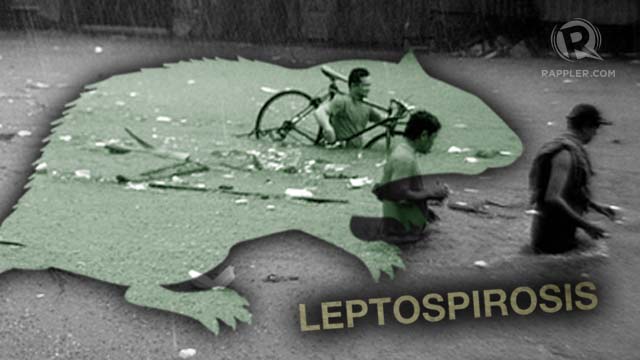SUMMARY
This is AI generated summarization, which may have errors. For context, always refer to the full article.

MANILA, Philippines – Over 600 cases of leptospirosis were recorded in Metro Manila in the span of a year, the highest in the country.
The Department of Health (DOH) on Thursday, October 10, said it activated a leptospirosis alert with the number of cases reaching 2,084 from October 5 of 2012 to the same period in 2013.
Below are the 4 worst-hit areas in the Philippines, according to DOH data:
- Metro Manila – 663 cases
- Central Luzon – 375 cases
- Western Visayas – 248 cases
- CaLaBaRZon – 195 cases
- Davao region – 140 cases
The infection affected Filipinos as young as 2 years old and as old as 83, with those older than 40 having the most number of cases.
Leptospirosis is a bacterial infection commonly acquired through rodent bites, direct contact with infected animals, or superficial cuts and open wounds which are exposed to a contaminated environment such as flood water.
Over-all decline
The health department added, however, that the number of leptospirosis cases decreased by 68% in 2013.
The figure for 2013 is less than half of the 6,439 cases recorded in 2012. The number of fatalities also decreased from 318 to 141.
Below are the Philippine areas that registered the highest decline in leptospirosis cases:
- Central Mindanao – 97% decrease
- Ilocos Region – 74% decrease
- Metro Manila – 71% decrease
- Western Visayas – 67% decrease
- Bicol Region – 65% decrease

Outbreak in Olongapo City
Meanwhile, a leptospirosis outbreak in Olongapo City started last Septemeber 27.
“As we continue monitoring this situation, we strongly advise those who are exposed to floodwaters to immediately wash themselves and take the prophylaxis treatment advised by the DOH,” said DOH Secretary Enrique Ona, who visited the city on Thursday, October 10. (READ: DOH: Olongapo leptospirosis outbreak under control)
As of Thursday, October 10, the death toll in Olongapo City has risen to 8.
Five of the patients who died due to “cardiopulmunary arrest with underlying cause of multi-organ failure secondary to leptospirosis” were 20 to 69 years old.
“All of them had a history of swimming in and ingestion of floodwaters,” said the health department in a statement.

Prevention
Treatment guidelines issued by the government explains that “appropriate, personal protective measures” must be employed including wearing of boots and overalls during heavy flooding.
Dr Anthony Leachon of the Philippine College of Physicians said early detection and treatment will help reduce leptospirosis fatalities.
“On the terminal stage, usually there’s already liver or kidney failure…Even if you go to the best centers, very little can be done. So dapat yan (the approach should be) preventive,” said Leachon.
Medical attention must be sought if a person suffers from an illness with acute fever (e.g. colds and flu, pneumonia, etc) for at least two days and exhibits at least two of the following symptoms:
- myalgia or muscle pain
- calf tenderness or pain at the back of the leg
- conjunctival suffusion or swelling of the eye
- chills
- abdominal pain
- headache
- jaundice or yellowish pigmentation of the skin
- oliguria or low urine output
– Rappler.com
Add a comment
How does this make you feel?
There are no comments yet. Add your comment to start the conversation.